Welcome to our blog on high-density kiwi plantations, where we delve into the fascinating world of cultivating this delicious fruit. This article will explore the key aspects of high-density kiwi plantation, including spacing, plants per acre, techniques, cost, and yield.
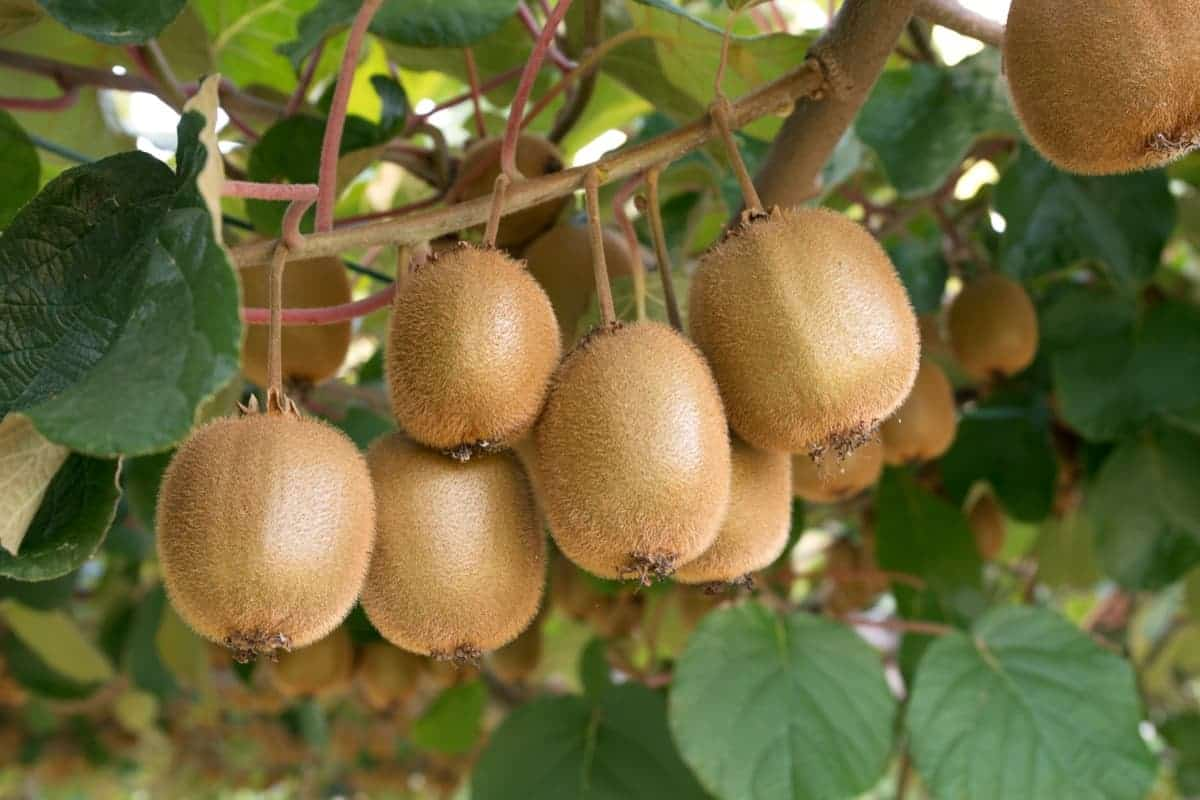
Whether you are a seasoned farmer or an enthusiastic gardener, this information will help you make informed decisions and maximize your kiwi harvest. So, let’s jump right in! We will cover everything you need to know about optimizing your Kiwi plantation for increased productivity and profitability. Get ready to unlock the secrets of high-density Kiwi farming!
What is High-Density Kiwi Plantation?
High-density kiwi plantation refers to a modern cultivation approach involving planting kiwi vines at higher densities than traditional methods. In this technique, kiwi plants are spaced closer together, allowing for optimal land utilization and increased productivity. Farmers can maximize their yield potential by adopting this method while efficiently utilizing available land resources. The higher plant density also facilitates better canopy management and efficient use of water and nutrients, ultimately leading to improved fruit quality and increased profitability.
Quick Facts on High-Density Plantation
- Pioneered for temperate fruits in Europe: High-density planting (HDP) techniques were introduced and implemented for temperate fruit crops.
- Beginning in the late 1960s: HDP was first practiced in Europe towards the end of the 1960s, marking the initial adoption of this innovative planting method.
- Definition of HDP: HDP is characterized by planting trees at a density that exceeds the maximum yield achieved when individual trees grow to their natural size.
- Manipulating tree size: HDP involves planting a greater number of trees than the optimum, achieved by managing the size and structure of the trees.
- Enhanced productivity: HDP is considered one of the improved production technologies to achieve higher productivity in fruit crops.
- Balancing yield and quality: HDP strives to balance vegetative growth and reproductive load, ensuring high yield and good fruit quality without compromising plant health.
- Successful application in India: HDP has proven beneficial for various fruit crops in India, including pineapple, banana, mango, apple, and citrus.
Benefits of High-Density Kiwi Plantation
- Induces precocity, increases yield, and improves fruit quality: High-density planting encourages early fruiting, resulting in higher yields and enhanced fruit quality due to better light exposure and efficient resource utilization.
- Reduces labor cost and production expenses: The closer spacing of plants allows for easier mechanization of tasks such as pruning, harvesting, and maintenance, reducing labor requirements and overall production costs.
- Enables mechanization of fruit crop production: The compact arrangement of plants in high-density plantations facilitates the use of machinery for various operations, saving time and effort.
- Enhances efficiency in resource utilization: With more plants per acre, resources like fertilizers, water, solar radiation, fungicides, weedicides, and pesticides can be applied more efficiently, leading to improved crop health and reduced waste.
- Fruiting branches are maximized, while structural branches are minimized.
- The arrangement of branches minimizes shade on other branches, ensuring adequate light penetration.
- Propagation methods, rootstock, and spacing influence plant architecture.
- For desirable architecture in temperate fruit plants, the focus is developing horizontal laterals, spacing small laterals along the central leader, maintaining fruiting spurs along the entire branch, and cultivating strong, self-supporting laterals.
- Fruiting spurs are ideally developed along the sides rather than the top or bottom of lateral branches. These architectural considerations help maximize fruit production and plant stability.
In case you missed it: How to Grow Kiwi in USA: A Farming and Production Guide to Planting to Harvesting for Beginners
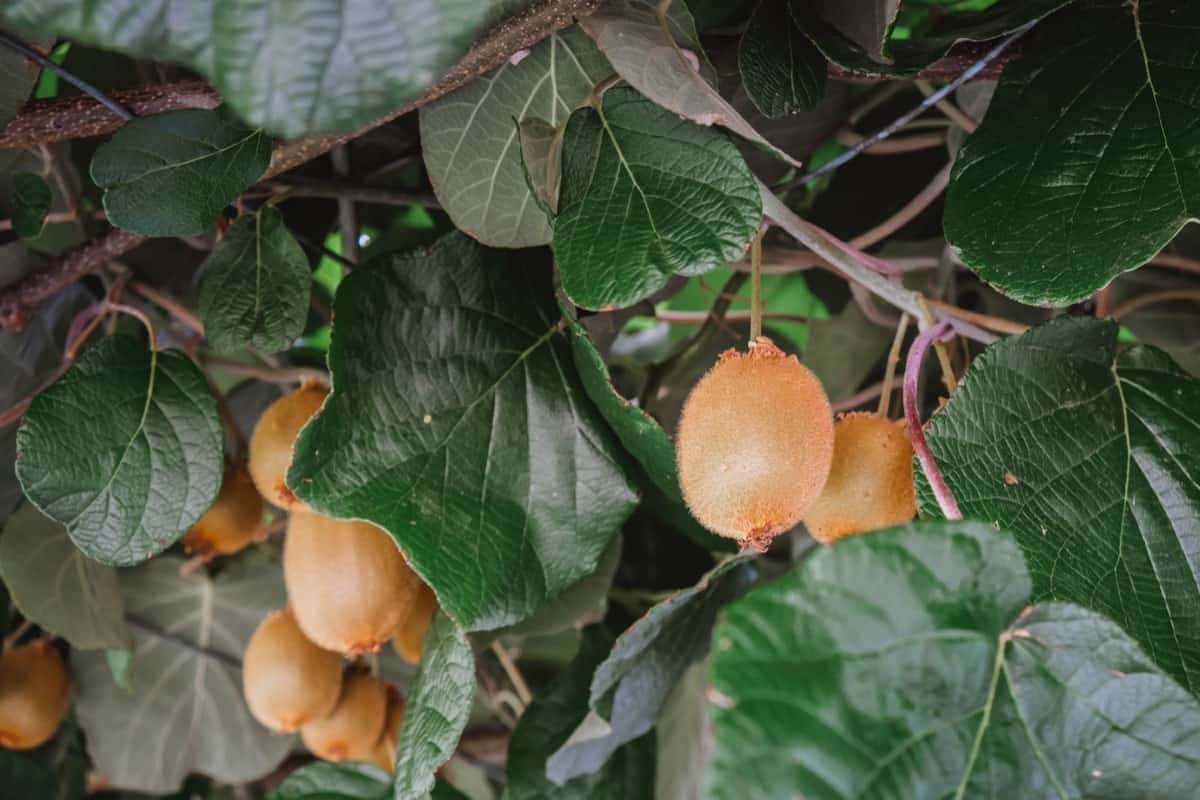
High-Density Kiwi Plantation Techniques
High-density kiwi plantation techniques utilize the espalier and cordon systems, efficient canopy management, and drip irrigation. These methods optimize vertical and horizontal space, maximizing productivity per unit of time and achieving higher returns with available resources.
The espalier system trains kiwi vines horizontally on a support structure, while the cordon system encourages a single fruiting branch along a wire. Regular canopy management ensures better light penetration and airflow. Drip irrigation minimizes water wastage by delivering water directly to the roots. These techniques enhance productivity, resource utilization, and profitability in high-density kiwi plantations.
Sustainable and Best Practices for High-Density Kiwi Plantation
Soil requirements and climate: Kiwi fruit thrives in warm and humid environments. The ideal soil for kiwi farming is deep-brown loamy soil that is well-drained and fertile. Regular monitoring of nitrogen (200kg/ha), potassium (150kg/ha), and phosphorus (55kg/ha) levels is essential. Providing wind shelter is crucial as strong winds damage kiwi plants, blossoms, and immature fruits.
Land preparation: Steep land can be contoured into terraces for kiwi plantations. Maximizing sunlight exposure is important, so rows should be aligned north-south. Land preparation, including pitting and manuring, should be completed by December for the plantation in January.
Plantation: Kiwi plants can be propagated through seeds, seedlings, or grafting. The plantation is typically done in January using the arbor or pergola system framework with a 6m distance between rows. Maintaining a 1:5 ratio of male to female plants is important for pollination.
Cold protection: Protection from cold during Spring and Autumn is necessary to prevent damage to kiwi vines. Techniques such as wind machines and water sprinklers can be used for protection.
Fertilizer requirements: Annual application of 20kg farmyard manure and 0.5 kg NPK mixture containing 15% Nitrogen is necessary for healthy kiwi growth. After five years, the same amount of farmyard manure and NPK should be applied along with 850-900g of nitrogen, 500-600g of phosphorus, and 800-900g of potassium per year.
Pruning and training: Pruning should start early to manage the growth of kiwi vines. Focus on creating a robust framework initially and encourage lateral growth along the wires. Proper pruning during winter is crucial for healthy vine development.
Irrigation: Irrigation should be provided in September-October during the initial stage of fruit growth. Regular irrigation at 10-15-day intervals promotes healthy plant and fruit growth.
Intercropping: Legumes and vegetables can be intercropped with kiwi plants.
In case you missed it: Top 15 Steps to Boost Kiwi Yield: How to Increase Production, Fruit Size, and Quality
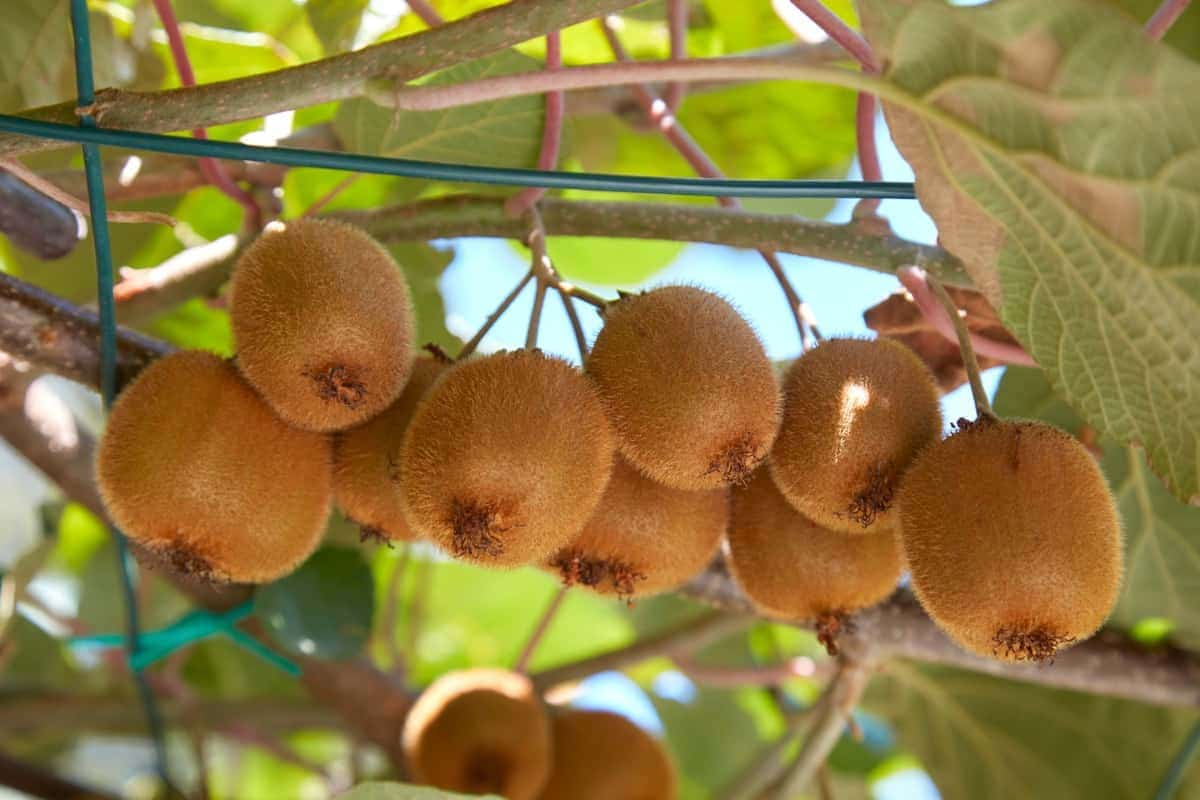
Harvesting: Kiwi plants bear fruit after 4-5 years, with commercial production beginning after 6-7 years. Harvesting is done based on fruit maturity, with larger fruits harvested first. Fruits can be wrapped and allowed to soften before market distribution.
Yield rate: High-density kiwi plants can yield 50-100kg per vine. Vines after seven years on trellis bare about 25-30 tonnes/ha.
High-Density Kiwi Plantation Spacing
The spacing in high-density kiwi plantations depends on the variety of kiwi and the training system used. The two common training systems are T-bar and pergola. In the T-bar system, a spacing of 4 meters is maintained between rows, while the distance between plants within a row is usually 5-6 meters. Accommodating 170–220 plants per acre. Hayward’ kiwifruit vines with varying in-row spacings of 1.5m, 3.0m, 4.5m, and 6.0m, and a fixed spacing of 4.5m between rows.
These spacings corresponded to plant densities of 1480, 740, 490, and 370 vines per hectare, respectively. A planting ratio of 7 female vines to 1 male vine was maintained by adding ‘Matua’ male vines to every fourth plant in every second row. On the other hand, in the pergola system, a spacing of 6 meters is maintained between rows. These spacing guidelines help ensure proper airflow, sunlight penetration, and easy access for maintenance and harvesting.
High-Density Kiwi Plantation Varieties
- Hayward: Known as the “traditional” or “green” kiwi, Hayward is the most widely grown variety worldwide. It has fuzzy brown skin and green flesh with a sweet-tart flavor.
- Bruno: This variety is similar to Hayward but has a smaller size and a slightly sweeter taste.
- Actinidia arguta: Also called to hardy kiwi or baby kiwi, this variety is smaller and has smooth skin. It is often eaten whole, including the skin, and has a sweet-tart flavor.
- Allison: This variety is preferred for its early ripening and excellent fruit quality. It has smooth, hairless skin and sweet, flavorful flesh.
- Monty: Monty is a high-yielding variety with large fruit size and good storage potential. It has a golden-brown skin and a sweet taste.
- Abbot: Abbot is known for its excellent adaptability to Indian climatic conditions. It has green skin and sweet, juicy flesh.
High-Density Kiwi Plantation Pruning Methods
To establish a well-formed framework of main branches and fruiting arms in high-density kiwi plantations, training, and pruning methods are essential. The supporting branches are erected before or shortly after planting the vines. Three supporting structures, including a single-wire fence or a kniffin system with two wires, are commonly used.
In case you missed it: High-Density Cashew Plantation: Spacing, Plants Per Acre, Techniques, Cost, and Yield
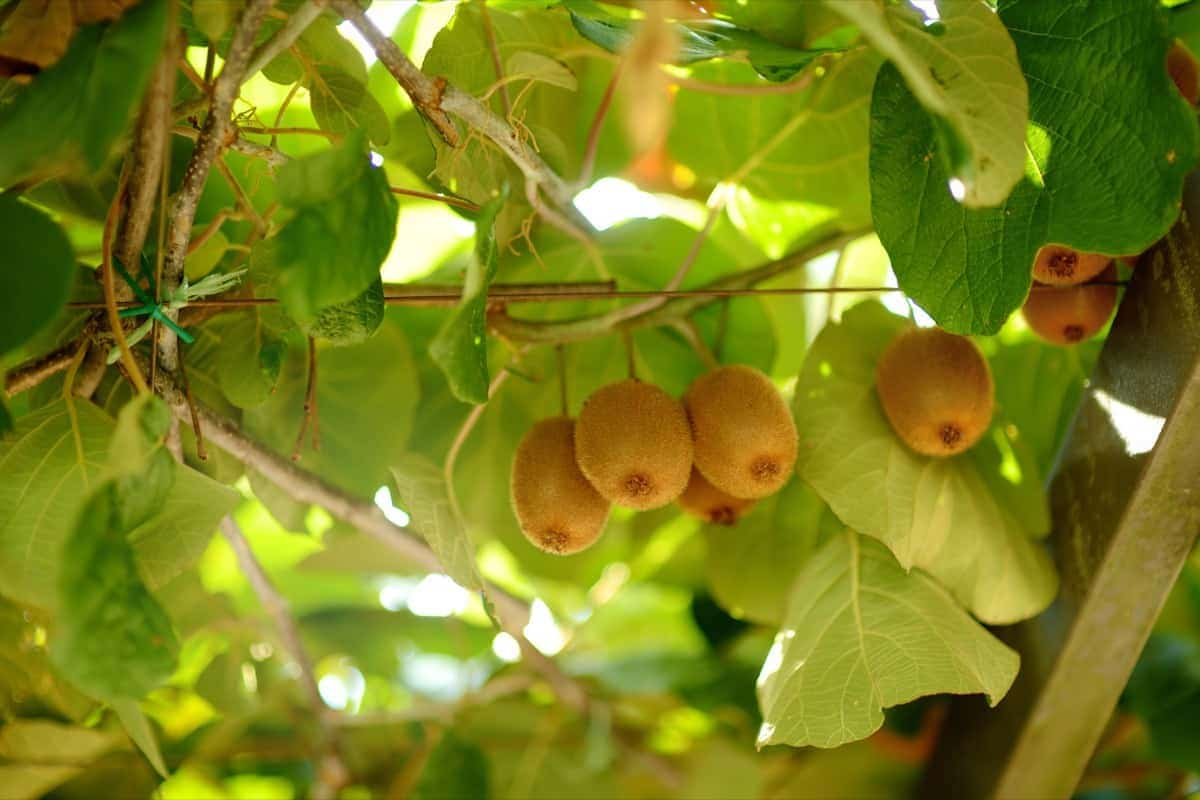
A top wire, usually 2.5 mm thick, is strung on pillars 1.8-2.0 m high and spaced 6m apart in a row. Care should be taken not to overstrain the wire tension during installation to prevent breakage under crop load. A cross arm on the pole carries two outrigger wires, and the laterals arising from the main branches are trained on the canopy formed by three wires. This training method is called the T-bar or overhead trellis/telephone system.
Optimal Fertilization for High-Density Kiwi Plantation
For optimal fertilization in high-density kiwi plantations, it is recommended to apply a basal dose of 20 kg of farmyard manure and 0.5 kg of NPK mixture containing 15% nitrogen annually. Once the kiwi plants reach five years of age, applying 850-900 g of nitrogen, 500-600 g of phosphorus, 800-900 g of potassium, and farmyard manure every year is advised.
Kiwi plants require sufficient chloride (Cl) as its deficiency can negatively impact shoot and root growth. However, excessive boron (B) and sodium (Na) levels can be harmful. The nitrogen fertilizer should be applied in two equal doses, with half to two-thirds applied in January-February and the remaining portion after fruit set in April-May. In young vines, the fertilizer should be mixed within the periphery of the vine, while for matured vines, it should be evenly broadcasted over the entire soil surface.
High-Density Kiwi Plantation Harvesting Tips
In high-density kiwi plantations, the vine begins bearing fruit at around 3-5 years of age, but commercial production typically starts at 6-8 years of age. The ripening of fruits occurs earlier at lower altitudes and later at higher altitudes due to temperature variations. During harvesting, the larger-sized berries are picked first, allowing the smaller ones to continue growing in size.
After harvesting, the fruits are gently rubbed with a coarse cloth to remove the stiff hairs on their surface. The firm and unripe fruits are then transported to the market, where they gradually soften and become edible within two weeks. Each kiwi vine yields around 50-100 kg of fruit. In a high-density plantation using trellis systems, the yield can reach approximately 25 tonnes per hectare after seven years of growth.
In case you missed it: High-Density Orange Plantation: Spacing, Plants Per Acre, Techniques, Cost, and Yield
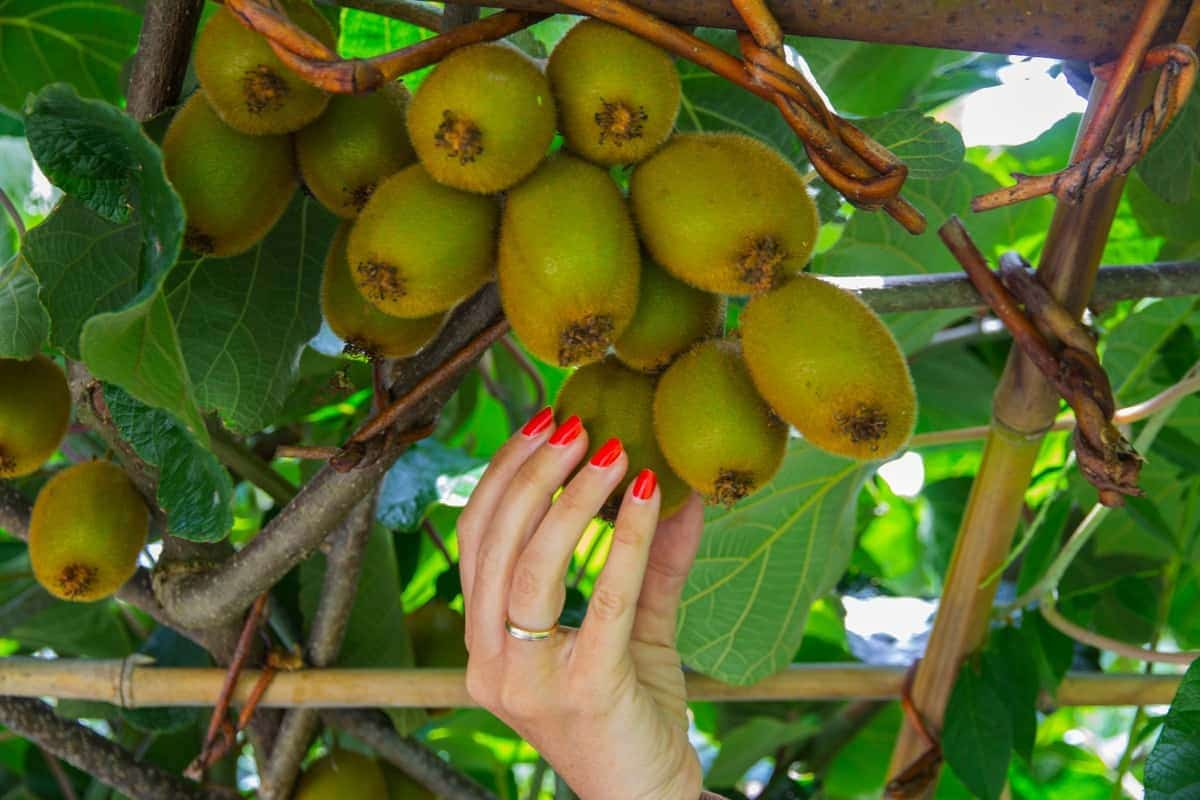
Post-harvest management of kiwi fruits is based on weight, with fruits above 70 g classified as an ‘A’ grade and those between 40-70 g as a ‘B’ grade. Kiwi fruits have good keeping quality and can be stored for up to 7-8 weeks in a cool place without refrigeration or 4-6 months in cold storage at -0.6 to 0°C.
Cardboard boxes of 3-4 kg capacity are commonly used for packing, and polythene liners help maintain high humidity for longer fruit preservation. Road transport by trucks/lorries is the preferred mode of transportation, and growers usually sell their produce through trade or commission agents at the village or market level.
High-Density Kiwi Plantation Cost Analysis (1 Acre Basis)
The cost analysis of a high-density kiwi plantation on a one-acre basis reveals various components that contribute to the total expenditure.
- Land development, including shaping and dressing the land, costs Rs. 4.0 thousand,
- While fencing the orchard with barbed wire amounts to Rs. 30 thousand.
- The installation of irrigation infrastructure, which involves a tube well and pump for drip irrigation, costs Rs. 50.0 thousand.
- Implementing a drip irrigation system on one acre requires an average expenditure of Rs. 20.0 thousand.
- Essential manual and power-operated equipment and implements account for Rs. 5.0 thousand.
- The construction of a grading/packing room, pump house, and labor room totals Rs. 30.0 thousand for building and storage.
- The cost of cultivation, including land preparation, planting operations, and labor, is estimated at Rs. 21.4 thousand.
- Additionally, a training structure for plants incurs an expense of Rs. 90 thousand.
The profit and loss account predicts a gross profit of Rs. 39.60 thousand in the first year, increasing to Rs. 65.9 thousand in the fifth year. The plantation yields range from 5 tonnes per acre in the fourth year to 8 tonnes in the seventh year, with returns valued at Rs. 90 thousand to Rs. 144 thousand, respectively.
In case you missed it: Shimla Apple Farming in India: Cultivation Practices, Planting to Harvesting, and Production
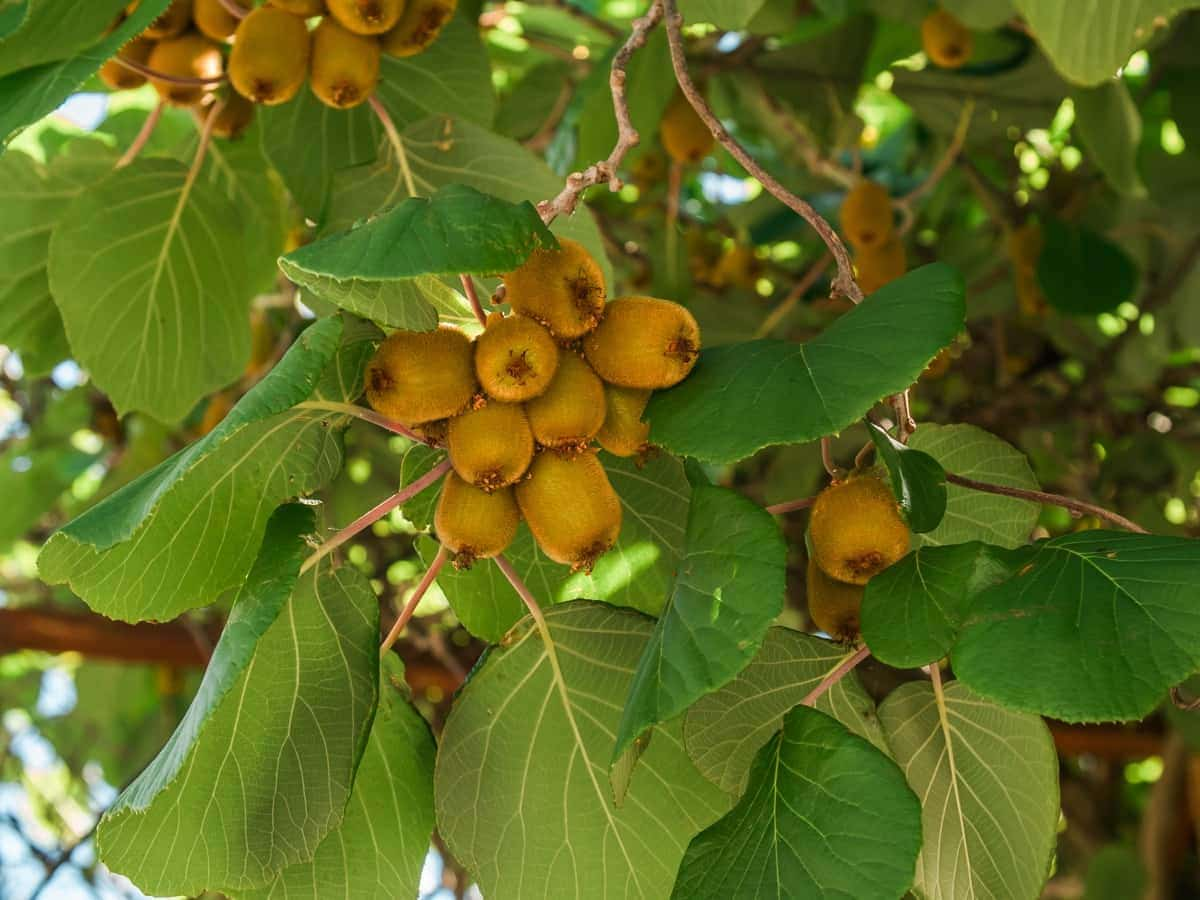
Conclusion
High-density kiwi plantation involves specific spacing and plant density per acre, implemented through advanced techniques. The cost analysis reveals the various components contributing to expenses while the expected yield increases over time, resulting in potential profitability.
- Types of Pesticides Used in Agriculture: A Beginner’s Guide
- Economical Aquaculture: A Guide to Low-Budget Fish Farming
- 15 Common Planting Errors That Can Doom Your Fruit Trees
- How to Make Houseplants Bushy: Effective Tips and Ideas
- Innovative Strategies for Boosting Coconut Pollination and Yield
- Pollination Strategies for Maximum Pumpkin Yield
- The Complete Guide to Chicken Fattening: Strategies for Maximum Growth
- Natural Solutions for Tulip Problems: 100% Effective Remedies for Leaf and Bulb-Related Issues
- Revolutionizing Citrus Preservation: Towards a Healthier, Greener Future
- Natural Solutions for Peony Leaf and Flower Problems: 100% Effective Remedies
- Maximizing Profits with Avocado Contract Farming in India: A Comprehensive Guide
- Natural Solutions for Hydrangea Problems: 100% Effective Remedies for Leaf and Flowers
- The Ultimate Guide to Choosing the Perfect Foliage Friend: Bringing Life Indoors
- From Sunlight to Sustainability: 15 Ways to Use Solar Technology in Agriculture
- The Ultimate Guide to Dong Tao Chicken: Exploring from History to Raising
- The Eco-Friendly Makeover: How to Convert Your Unused Swimming Pool into a Fish Pond
- Mastering the Art of Delaware Chicken Farming: Essentials for Healthy Backyard Flocks
- 20 Best Homemade Fertilizers for Money Plant: DIY Recipes and Application Methods
- How to Craft a Comprehensive Free-Range Chicken Farming Business Plan
- Brighten Your Flock: Raising Easter Egger Chickens for Beauty and Bounty
- How to Optimize Your Poultry Egg Farm Business Plan with These Strategies
- Subsidy for Spirulina Cultivation: How Indian Government Schemes Encouraging Spirulina Farmers
- Ultimate Guide to Raising Dominique Chickens: Breeding, Feeding, Egg-Production, and Care
- Mastering the Art of Raising Jersey Giant Chickens: Care, Feeding, and More
- Ultimate Guide to Raising Legbar Chickens: Breeding, Farming Practices, Diet, Egg-Production
- How to Raise Welsummer Chickens: A Comprehensive Guide for Beginners
- How to Protect Indoor Plants in Winter: A Comprehensive Guide
- Ultimate Guide to Grow Bag Gardening: Tips, Tricks, and Planting Ideas for Urban Gardeners
- Guide to Lotus Cultivation: How to Propagate, Plant, Grow, Care, Cost, and Profit
- Agriculture Drone Subsidy Scheme: Government Kisan Subsidy, License, and How to Apply Online
- Ultimate Guide to Raising Araucana Chickens: Breed Profile, Farming Economics, Diet, and Care
- Bringing Hydroponics to Classroom: Importance, Benefits of Learning for School Students
- Ultimate Guide to Raising Polish Chickens: Breed Profile, Farming Economics, Diet, and Care
- Ultimate Guide to Raising Australorp Chickens: Profile, Farming Economics, Egg Production, Diet, and Care
- Silkie Chicken Farming: Raising Practices, Varieties, Egg Production, Diet, and Care
- Sussex Chicken Farming: Raising Practices, Varieties, Egg Production, Diet and Care